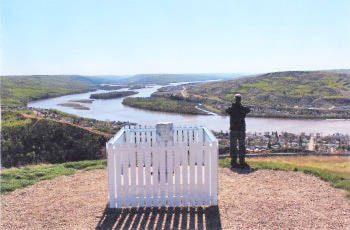One of the most unique and unusual stories which came out of the Cariboo Gold Rush was the story of “12-Foot” Davis.
Born in 1820 in the hills of Vermont, Henry Fuller Davis came to be a legend, not only in the Cariboo, but also in the Peace River country.
In 1849, he headed out to California, one of the original “Forty Niners” in the gold rush in that area.
He didn’t do particularly well in that gold rush, finding just enough gold to make ends meet, so when he heard about the fabulous riches to be found in the Cariboo gold fields, he headed north.
Unfortunately, like so many other goldseekers, by the time Davis arrived all of the prime gold-bearing land had already been staked out.
On one small tributary to Williams Creek named Willow Creek, two miners were doing particularly well on two adjacent claims.
By law, a single claim could only be 100 feet of creek frontage.
Even though Davis could neither read nor write, he had a good eye for distances and it appeared to him that the two Willow Creek claims measured more than 100 feet each.
He went out in the middle of the night and measured them, and he found that they measured exactly 212 feet.
The next day he went to the gold commissioner and asked for a legal resurveying of the two claims.
Sure enough, he was proven correct, and he quickly filed a claim for the 12-foot discrepancy, right in the middle of the two claims.
From these 12 feet, so the story goes, he extracted $12,000 worth of gold. In reality, he actually pulled out between $20,000 and $30,000, which in today’s world would be worth somewhere in the neighbourhood of half a million dollars.
From this astute piece of gold sleuthing, Davis earned the nickname he would carry for the rest of his life: “12-Foot-Davis.”
As soon as his claim petered out, Davis packed up and headed north to the Peace River area where he began trading goods for furs.
He used his earnings from the gold mining to establish a string of trading posts, in direct competition with the Hudson’s Bay Company.
Each year, he brought supplies overland by pack train from Soda Creek to his post at Hudson’s Hope and thence by river to Fort Dunvegan and Fort Vermillion.
Even though the HBC was a world-wide trading enterprise, Davis challenged that supremacy for almost 40 years.
He helped form an alliance of mainly French Canadian, Cree and Métis Free Traders who traded goods in exchange for furs or cash.
These traders were proud not to be associated with the HBC and they enjoyed being a thorn in the company’s side.
Davis earned a reputation as “the Yankee Trader” and it was said that he was honest, fair and scrupulous in all of his dealings.
By the late 1800s, the HBC had bought out most of the other Free Traders on the Peace River, but Davis remained independent until his death.
Because he was illiterate, Davis had to rely upon his employees to do his reading and writing for him. One story tells about him receiving a letter from his friend and rival, the factor of the nearby Hudson’s Bay Company post.
Being too proud to admit to the servant who delivered the letter that he could not read, he made a great show of studying it.
Because letter writing was rare, and often used as a request for help in emergency situations, Davis concluded that his friend had fallen ill and was in need of medicine.
He thought he recognized the number two in the letter, so he took two bottles of his best whiskey and sent them back to the HBC factor with the runner, telling him that he thought this medicine would assist with whatever ailed him.
Months later, when a literate friend dropped by, Davis asked after the factor’s health and showed the letter to him.
The letter proved to be an invitation to dine at the HBC post in celebration of the new year.
Davis shrugged off the embarrassment.
“It was that damned two that set me wrong,” he grumbled.
On the trail, Davis was both tough and hard working. He was not a big man, but he would commonly carry loads of up to 200 pounds on his back, double the weight he required of his men.
Because of his strength and tenacity, the local natives called him “the Timberwolf.”
As Davis grew older, his eyesight and his legs began progressively to fail him.
In time, he became blind and unable to walk, but even these afflictions did not stop his trading activities.
He was returning to his post at Fort Vermillion when he died in September of 1900 at the Lesser Slave Lake Mission.
Before his final breath, one of the nursing sisters tending him asked if he was afraid.
His answer rather summed up his life: “No, ma’am. I ain’t never killed nobody. I never cheated nobody. I always tried to help fellers and be their friend. I know I ain’t lived perfect, but I think the Lord understands. No ma’am, I ain’t afraid to die.”
Later, in 1912, in keeping with an earlier promise he had made to 12-Foot-Davis, Peace River Jim Cornwall, another legendary figure of the region, had the remains of the Yankee trader buried on Grouard Hill, overlooking the confluence of the Smokey and Peace rivers, just above the main HBC post in the area.
Apparently, it was Davis’ wish to be buried “where I could pee on the Hudson Bay Company.”
The grave marker reads: “Twelve Foot Davis. Pathfinder, Pioneer, Miner, and Trader. He was Every Man’s Friend and Never Locked his Cabin Door.”
In the community of Peace River, Alta., there also stands a 12-foot wooden carving of Twelve Foot Davis, a tribute to a legendary figure who carved out different niches in two widely separated areas of our province.
